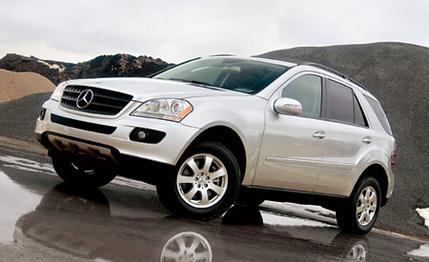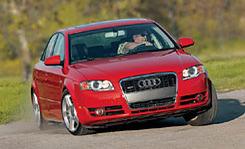
 Road Test
Road Test
Let's just say the A4 is back wearing its halo again after briefly falling into disfavor last year when it-- oh, the ignominy!--finished fourth in a four-car comparison ["Sustainable Sports Sedans," C/D, October 2004].
Age got the old one. It was only three, but given the rate of progress in the car world these days, three years for a car is like 30 for a horse.
Now there's a new A4, much improved in the areas that get the editorial blood stirring, and all's forgiven.
New in this case is a sort of "bipolar new." It depends on where you're standing (or sitting). To those on the outside, the look is new, with the mouth on the front saying "Oh!" just as on the bigger Audis. There's also a sharp crease in the sheetmetal running the full length of the flanks, which has the effect of de-blobbing the otherwise soft shape. Behind, the taillights are stretched wider; they now lap onto the decklid--this to visually broaden the shoulders, says Audi.
Of course, the driver sees none of this. To him, the look is same-old, same-old, except for a band of textured aluminum trim sweeping across the dash (this is to make the inside look wider), or when he happens to look down at the center console, in which case he'll see two no-excuses cup holders. Most German cars, if they have cup holders at all, have the most amazing contraptions hung on as afterthoughts when the designers finally acknowledged that Americans really insist on such things. These Audi receptacles suggest a Honda-like willingness to give us exactly what we want.
New doesn't really mean "new new." Although the exterior is longer by 1.6 inches, most of it added in back, the interior space is dimensionally about the same as before. But the A4 didn't need to be all-new. We've always liked this compact four-door for its driver-friendly packaging (even as a fourth-place finisher, the 2004 model earned top marks for ergonomics) and good-taste appointments.

 What the old car lacked was an attitude of eagerness. No one will accuse the '05 of that sin. It attacks the road, even with the base 2.0 turbo four that replaces the old 1.8T. The now-standard six-speed manual beats heck out of the old five-speed, too, with much shorter and smoother throws and a fluid motion through the maze.
What the old car lacked was an attitude of eagerness. No one will accuse the '05 of that sin. It attacks the road, even with the base 2.0 turbo four that replaces the old 1.8T. The now-standard six-speed manual beats heck out of the old five-speed, too, with much shorter and smoother throws and a fluid motion through the maze.
You can opt up to the new 3.1-liter V-6, good for 255 horsepower at 6500 rpm. It's a stirring performer. But don't be in a hurry to make that choice. Unlike the old 1.8, which needed time for the turbo to get into the mood, and for the revs to make torque, the 2.0 is strong all the time. This is a fresh design using direct injection of gasoline into the combustion chamber, combined with a turbocharger and an uncommonly high 10.5:1 compression ratio. Full torque, all 207 pound-feet of it, is on tap from 1800 rpm to 5000. That's a broad torque curve. Pull into traffic smartly, using Quattro traction to put all the power down, and acceleration is enough to put you into the first-gear redline before you're fully straight in the lane. (On front-drive models, full power in first gear brings on a bit of torque steer now.)
The new four is strong all the time, for a 2.0-liter, but it gives plenty of encouragement to work the lever. In hilly sections, fifth and sixth gears are really too long for speeds under 40 mph (1400 rpm in sixth, 1700 in fifth). The engine makes grunting sounds down low in the range, too. No problem--shifting is always fun in the A4.
Track-test numbers confirm the A4's new attitude: 0 to 60 has quickened almost a full second to 7.2, from 8.1. The pressurized four keeps pulling through the quarter, too, up 5 mph in trap speed to 92. ET is quicker by 0.7 second at 15.5.
With an engine this strong, we're surprised Audi has resorted to hyping the throttle linkage, the old trick of big results from small foot motions early in the travel. It makes launching trickier in six-speed cars and adds unpredictability to acceleration response with the automatic.